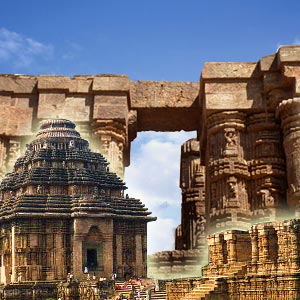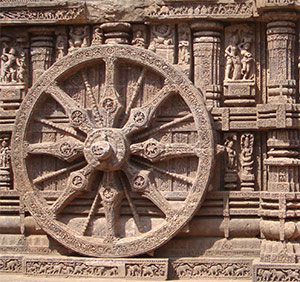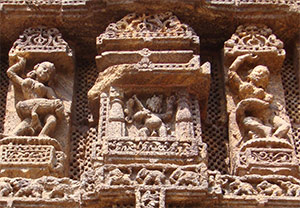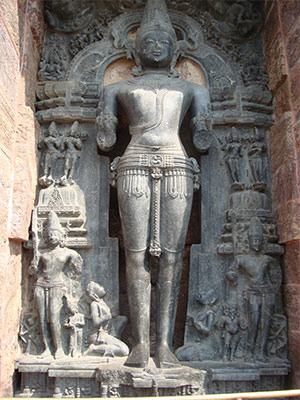Konark Sun Temple
Also known as Konaditya or Arkakshatra, Konark is a combination of two words - Kona means corner and Arka means sun. Built in the 13th century AD by King Narasimha Deva, Konark Sun temple is one of the oldest and magnificent temples of India.
The temple was ruined and remained this way until the 19th century when it was unearthed and revamped. Though the tower over the main temple (garbagriha) is absent, the temple is breathtaking and stands as a majestic representation. Konark Sun Temple has been declared by UNESCO as a world heritage site, and speaks volumes of Kalingan architecture.
It is understood from Hindu mythology that Samba (King of Krishna and Jambavati), trespassed into the bathing chamber of Lord Krishna's wife and as a result was cursed to become a leper by Lord Krishna. To alleviate himself from the curse, he was asked to worship Sun God at the Northeast sea coast of Puri.
On reaching the place, the king found the image of Sun God seated in a lotus. There he worshipped the Sun God as he was asked to and was relieved of the curse. The entire temple bears the look of a chariot with 24 wheels and each wheel is about 10 feet in diameter and has a set of spokes and intricate carvings. The temple is hauled by seven horses and guarded by two lions.
Konark Sun Temple
Also known as Arkakshetra, Konark is part of the Golden triangle comprising Bhubaneshwar, Puri and Konark. Konark is located 65kms from Bhubaneshwar and 35kms from Puri. The nearest airport and railheads close to Konark are Puri and Bhubaneshwar. Konark is well connected by road to and from all over India. Within the city taxis, mini buses and private cars are available to move around with ease.
History of Konark Sun Temple: Konark Sun Temple has exquisite intricate sandstone sculptures which weathered hundreds of years of destructive forces - both natural and human. Black Pagoda as it was named due to the oxidized ferruginous sandstone used in the construction of this Surya (Sun God) temple was built by the King Narasimha Deva in the year 1238-1250 AD. The Muslim invasion in 1508 ended in the destruction of parts of the massive edifice. Worship of the Sun God was abandoned at the aftermath of the Muslim rule in Orissa which left the temple desolate. The temple was lost to the world - until the British stumbled on this magnificent temple.
Kalinga temple architecture is one of the finest in India - with exquisite details and symmetry in all the sculptures. The meticulously carved scultures depict Sun God, chariots drawn by 7 horses in addition to a layer of hedonistic scenes. These erotic sculptures may even rival that of Khajuraho temple. To sum in the words of the Bengali Poet - Rabindranath Tagore 'the language of stone surpasses the language of man'.
Konark Sun Temple is open on all weekdays and a fee of Rs.10/- is charged per head (for Indian citizens and neighboring countries - people aged above 12 while it is 5 US Dollars for people from other countries), entry is free on Fridays. The temple is open from sunrise to sunset everyday. October to March is the best time to visit Konark though the place is worth a visit all through the year.
Konark is hot during summers and the temperature can go up to 43ºC, during winters the temperature drop down to 11ºC. Konark has numerous budget accommodations as well as luxurious accommodations; there are various government guest houses as well as travelers bungalows.
What to see in Konark sun Temple
To see and enjoy the place in detail it is advisable that tourists stay overnight and derive pleasure from the stay. Intricate sculptural work is the hallmark of the architectural splendor of the Konark Temple. The images of the Sun God are positioned so as to catch the sun's rays at dawn, dusk and noon. Perfect proportions and magnificence of the structure make the Sun temple at Konark a breathtaking sight. The black pagoda is unique as much as the 24 giant stone wheels of the chariot.
- Watch and enjoy the well-lit temple at night, the temple is beautifully illuminated and portrays an awe-inspiring marvel to the visitors.
- The outer part of the temple is called Natmandir, and can be reached by a flight of stairs. The roof has collapsed long back but the pillars are beautifully carved and the sculptures speak of the various features of life.
- The central part of the temple is called Jagmohan and the main part of the temple that houses the deity is called the garbhagriha. These two parts combine together to form the Chariot of the Sun.
- The entrance of Jagmohan is the adorned sealed entrance and can be reached by climbing a flight of stairs. This part of the temple is one piece that has 'surasundaries' playing the musical instruments depicted on the top section.
- The entire temple is a piece of architecture that can be enjoyed thoroughly.
- A museum is located close to the temple complex and houses few of the endangered sculptures.
- The annual festival of dance is held in the month of December every year and draws crowd and participants from across all over India. Konark dance festival showcases various Indian dance forms.
- Chandrabhaga is the beach that is close to the Konark sun temple and offers visitors the best of sunrise and sunset views.
KONARK TRAVEL
Konark is about 80 km from Bhuvaneswar, Odisha (Orissa). On the road, you can reach Konark from Puri on Puri-Konark Marine drive - a distance of 35km. You can take the NH 5 from Southern India if you drive down from South. The Konark Marine drive is through picturesque Beach Forest reserve and Olive Turtle Beach Reserve area.
|












































